
by BCB Property Management | Oct 24, 2019 | New York City
When the Museum of Modern Art renovates, it doesn’t take half-measures. On October 21st, the museum officially reopened its doors to the public and — at long last — welcomed visitors into its expanded campus.
The expansion adds 40,000 square feet to MoMA’s footprint and reportedly cost upwards of $450 million to complete. Today, the museum’s borders span the majority of the 53rd Street block between Fifth and Sixth Avenues. It was an admittedly tricky project to execute, as the architects needed to meld two sites — three floors of a residential tower on 53 West 53rd Street and an entirely new building at 45 West 53rd Street — into a cohesive whole with the museum’s original campus. It’s fair to say that MoMA met the challenge head-on, albeit with help; plans for the renovation were developed by the museum with assistance from the architectural firm Diller Scofidio + Renfro and in collaboration with Gensler.
According to MoMA, the renovations served as a means to “rethink how we share art with you. We’ve reinstalled the entire collection to share exhilaratingly broad views of the art of our time in a way that is always evolving.” And it’s true — besides offering access to three floors of collection galleries and thousands of drawings, sculptures, video, and other artworks, some spaces within MoMA’s expanded campus also provide visitors opportunities to engage with art in a more personal and affecting way.
In the new Marie-Josée and Henry Kravis Studio, for instance, museum-goers experience live and experimental programming firsthand. As one writer for MoMA puts the matter, “Through new commissions, festivals, and residencies, as well as presentations of landmark works from the collection […] you can directly engage with artists and works in process and see pivotal and emerging works in dialogue.”
Similarly, the new Paula and James Crown Creativity Lab provides an experimental space where visitors can interact not only with MoMA’s art, but the artists who create it. Until August of 2020, the Lab will see a steady calendar of conversations and workshops that explore the environments and cultures that underpin artistic practice.
MoMA’s new campus has been a long time in the making. The first phase of the project began in 2014 with renovations to the east wing; that same year, MoMA announced its intent to demolish the former American Folk Art Museum building and construct new gallery space atop its foundation. MoMA faced some blowback for the demolition, both from the former building’s architectural team (Tod Williams Billie Tsien Architects) and supporters of the Folk Art Museum. The project pushed on; by the end of 2017, MoMA had completed the first phase of renovations on its east wing and began construction on the west. Now, after years of effort, the museum’s transformation has finally reached a stopping point.
People seem to appreciate the change — for the new galleries, and for the unique architectural environment that encompasses them. As one writer describes for Fast Company: “The building is made up of a series of sharp angles and steel lines, but the galleries are woven into a series of seemingly infinite loops; the experience of viewing each exhibit felt more like an accidental discovery than something I could have ever intentionally charted. The building feels like a puzzle worth solving.”
In a way, the renovated building has itself become art — a tangible, thought-provoking, and walkable masterpiece that exudes the modern artistic spirit and curiosity.
Want more insights into New York’s art and culture scene? Check our blog post on the Coolest Pop-up Museums in NYC!
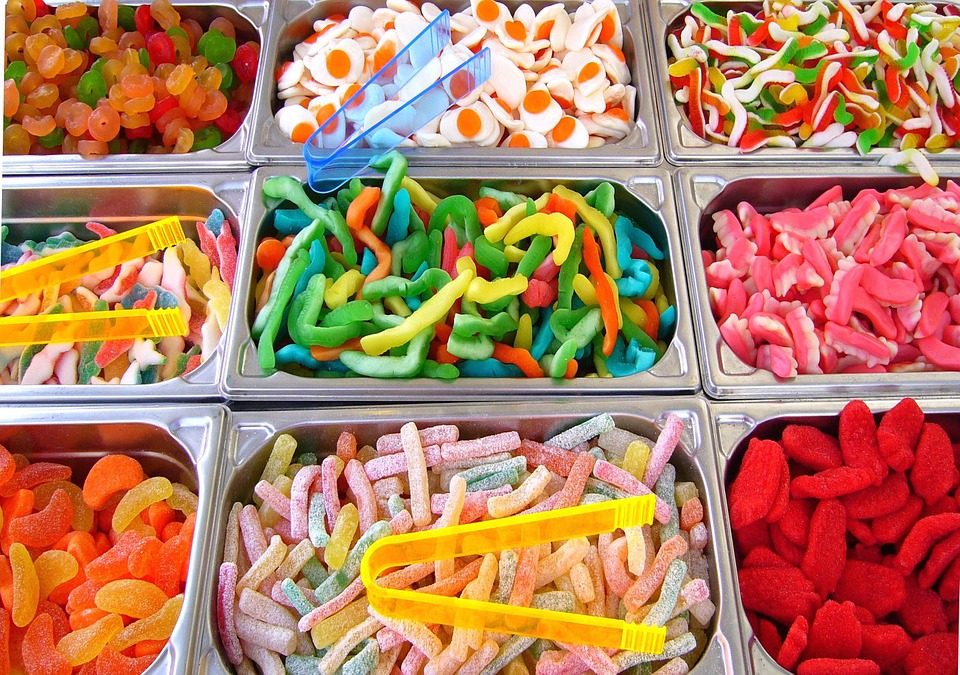
by BCB Property Management | Oct 22, 2018 | Neighborhoods
Museums are known to house sacred pieces that shape history and society as we know it. Silently walking the halls while using your eyes alone to take in the exhibit is becoming a routine of the past. New types of exhibitions are springing to life in cities all over the world. Enter the pop-up museum, created specifically for hands-on interaction and the boosting of everyone’s social media presence. Here are the top pop-up museums in New York City right now.
The Color Factory
A bright take on art makes this museum one unlike any other. It is centered around – you guessed it – colors. It features prestigious artists, illustrators, makers and designers, non-profits, and local food vendors. Located in a 20,000-square-foot Hudson Square space in Soho, this pop-up highlights all the happiness and fun that come from vibrant colors. No outfit is too flashy here.
The Museum of Pizza
The website describes this pop-up as “A space to bask in multi-sensory, psychedelic pizza joy.“ The $35 ticket will buy you a tour of pizza-themed rooms such as the “cheese cave,” a “pizza beach,” and others. Otherwise, they’re a little cheeky as to what it all actually means. Whether you’re intrigued or creeped out, this experience is guaranteed to be “marvelously-’grammable.” Bring your cameras and all cheesy pizza hashtags. It will likely make you hungry.
Candytopia
Here, everything is made of candy thanks to the talents of Hollywood “candy queen” Jackie Sorkin and fabricator Zac Hartog. The website sums up the museum as “where colossal candyfloss constructions meld with a tantalizing taffy twistedness!” If that doesn’t sum it up, you’ll have to see it for yourself. A tour through Charlie’s Chocolate Factory may not live up to this modern-day pop-up. Bring a sweet tooth and your Instagram game.
The Velvet Underground Experience
If you think you should’ve lived your best years in the 1960s, this museum may be your cup of tea. Connect with Lou Reed in his prime and go into a technicolor world befitting Andy Warhol’s iconic banana album cover. This pop-up features six films, 350+ photos, 1,000+ objects, and special events such as concerts, lectures, installations, exhibitions, screenings, and masterclasses.
Museum of Illusions
Want to see your head on a platter without actually losing it? This is the place to do so. When you’re in this museum, everything is an optical illusion. It will make you question your senses and learn about them at the same time. Nothing is what it seems until you leave the building. Great for kids and adults alike. Perfect for selfies.
The weather is getting chilly, so go inside to warm up and check out these delightful budding forms of pop culture in the greatest city in the world. The caveat to these Millennial-centric pop-up museums is that they are only around temporarily. Get your selfies in before they close!
by BCB Property Management | Feb 6, 2018 | Neighborhoods, New York City
From the Statue of Liberty to the Washington Square Arch, public art is an inextricable part of the NYC landscape. Outside of these established landmarks, there’s never a shortage of intriguing and thought-provoking pieces popping up across the five boroughs. These are a few public artworks currently on display around the five boroughs that help keep New York a vibrant center of culture, showing you don’t always need to visit a museum to get in touch with the world of art.
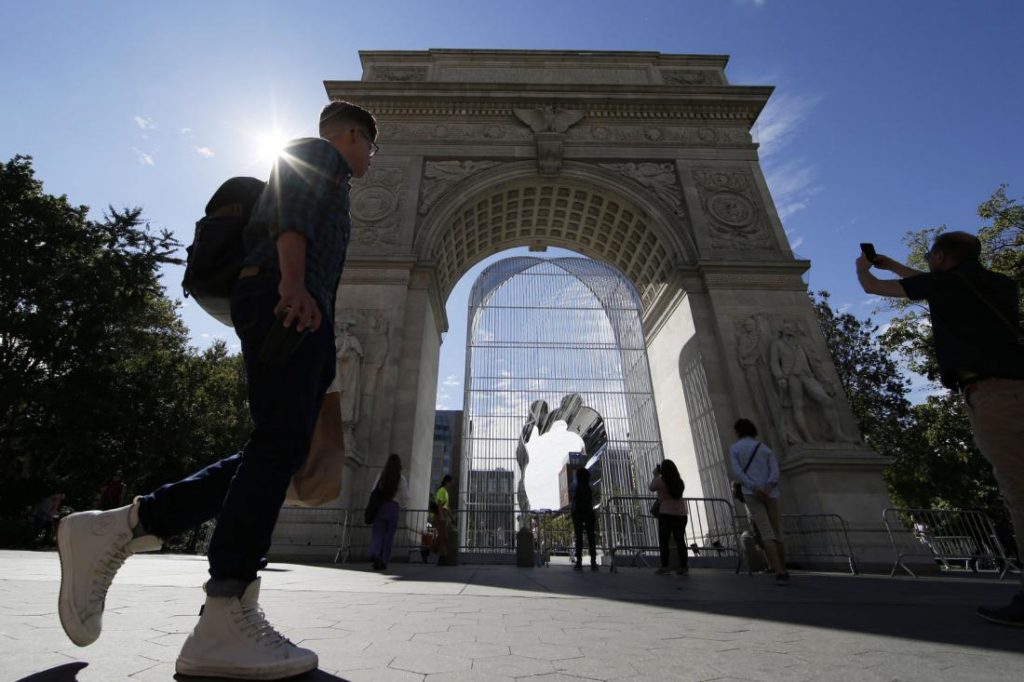
Source: upi.com
Various neighborhoods
Good Fences Make Good Neighbors
The sometimes controversial Chinese dissident’s latest piece uses the entire city as its canvas. At sites across Manhattan and Brooklyn, Ai Weiwei’s Good Fences Makes Good Neighbors serves as compelling commentary on the borders and separations that define our lives. Consisting of steel fences and pictorial banners strategically placed across the city, this piece is just the latest example of global artists using the city’s streets to make a vital statement.
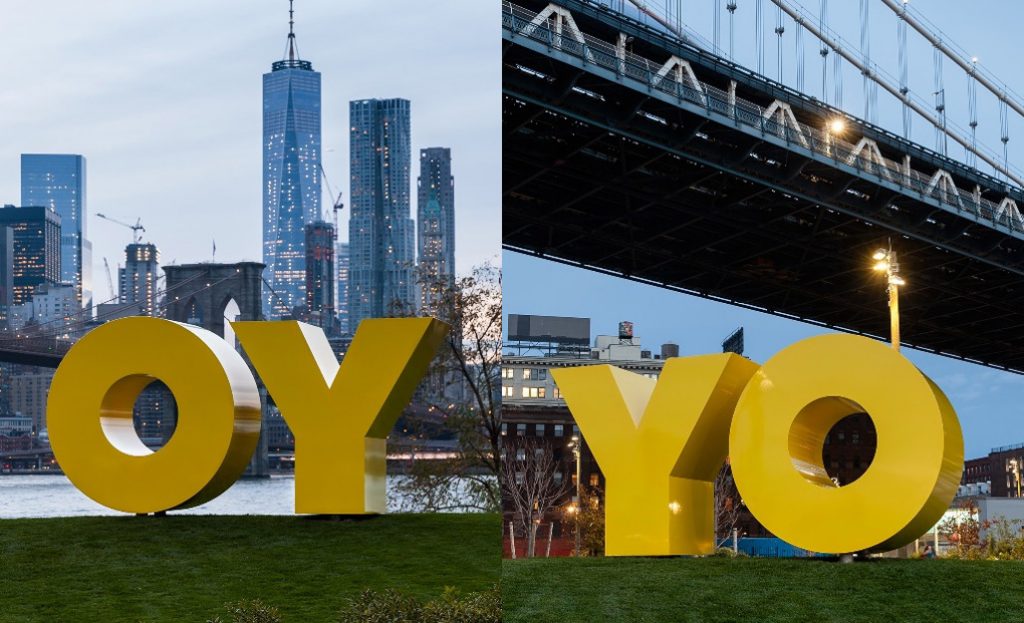
Source: brooklynjewish.org
Brooklyn
OY/YO
On the more lighthearted side, this bright yellow construction consists of just two letters that carry a multitude of meanings for countless people. The 8-foot tall aluminum piece, depending on where on the Williamsburg’s North Fifth Street Pier and Park you’re standing, reads “YO” as in “I” in Spanish, or the slang “hey” salutation familiar to just about all New Yorkers. From the other side, the two letters read “OY,” perhaps a nod to the city’s many Jewish residents. Either way you choose to look at it, this piece by Deborah Kass is worth experiencing in person.
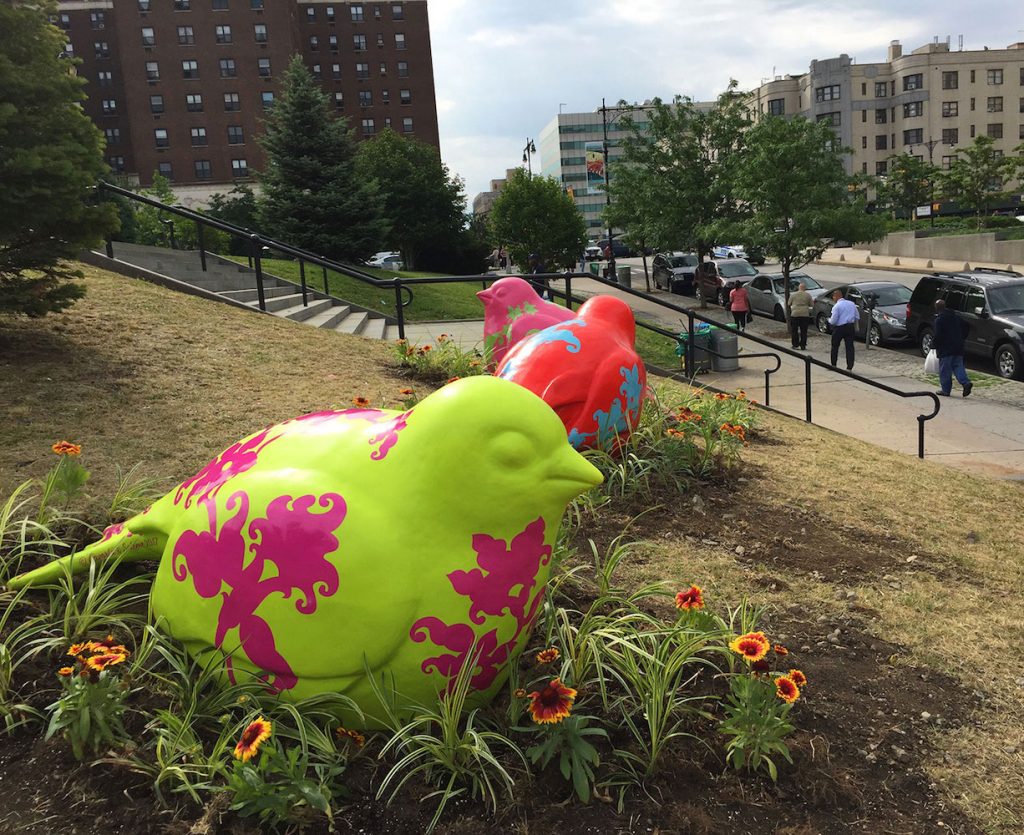
Source: nycgovparks.org
The Bronx
Flying High for Equality
A highlight of the City Parks Department’s Art in the Parks initiative, Flying High for Equality sits perched on the southern slope of Joyce Kilmer Park along East 161st Street in the Concourse Village neighborhood in the Bronx. A flock of multicolored sparrows representing the varied communities found in the city overlook the colorful neighborhood adjacent to Yankee Stadium.
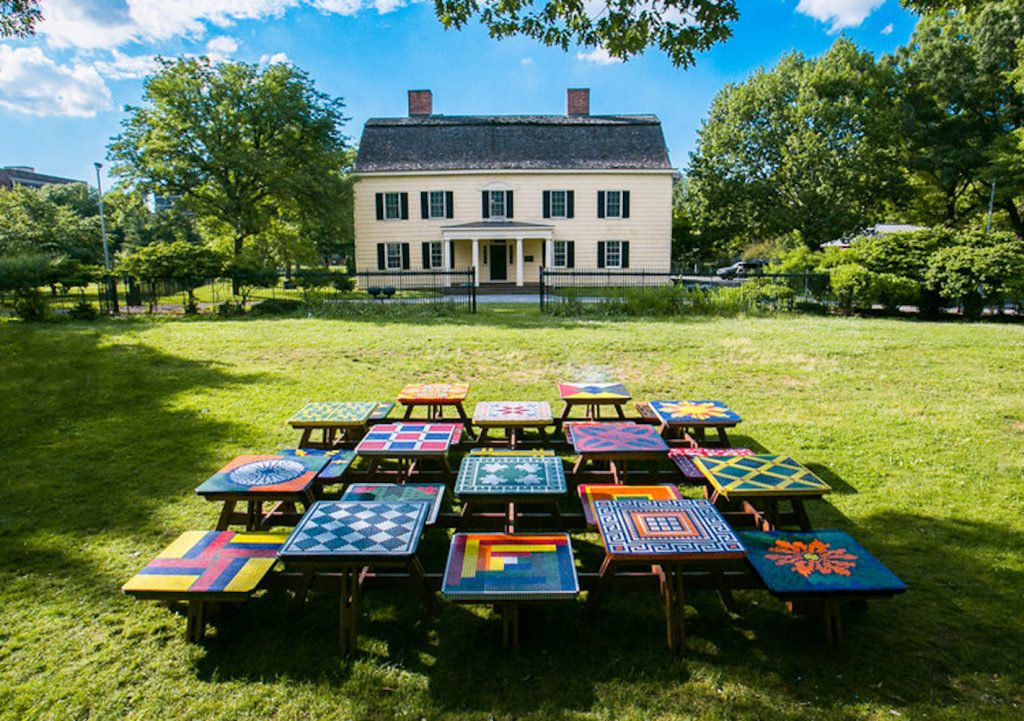
Source: risapuno.com
Queens
Common Ground
Another piece sponsored by the Parks Department brings vivid color to the green parks of New York. Queens’ Rufus King Park in Jamaica already stands out thanks to a colonial manor central to the park, and Common Ground brings a more down-home feeling to the compact park space. Brightly colored benches featuring mosaic designs comprise this utilitarian piece of art, providing a place that encourages park visitors to come together and enjoy friendship and camaraderie any time of year.

Source: untappedcities.com
Staten Island
Eyes
The work of Polish-born artist Fitzhugh Karol, this highly interactive piece forms steel silhouettes into something new. Part public art, part playground, these works invite visitors to play and enjoy them while offering a highly unique aesthetic to Stapleton’s Tappen Park. Drawing inspiration from the freighters in nearby New York harbor, Eyes combines steel material with bright color.
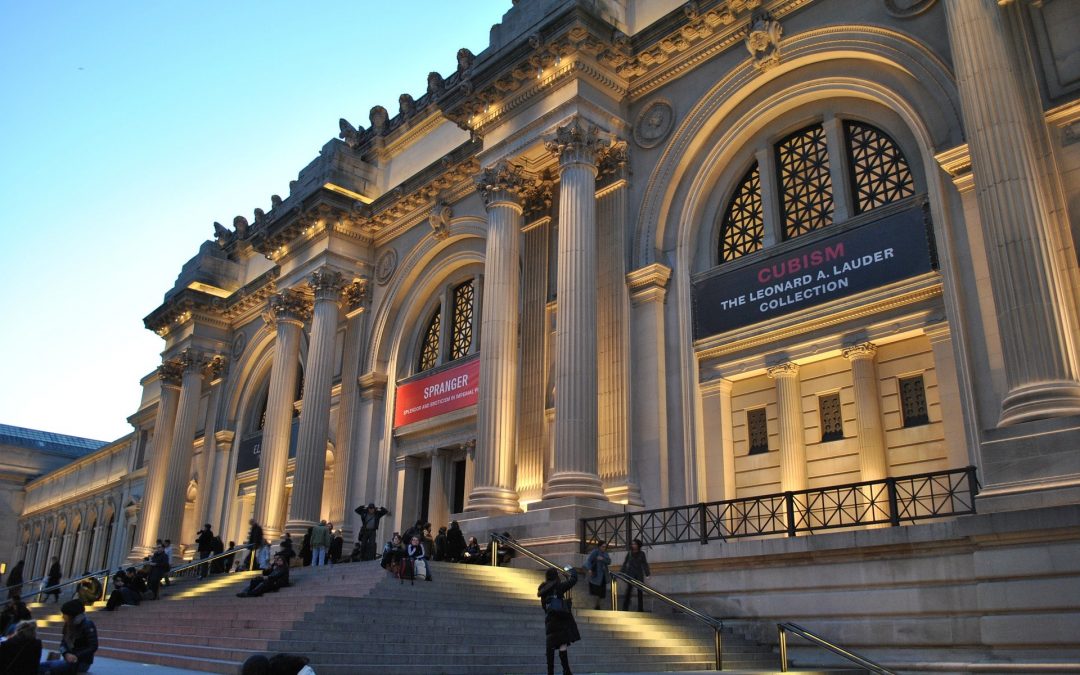
by BCB Property Management | Dec 5, 2017 | Neighborhoods
Summer weather is a distant memory by now, but NYC’s best museums have tons of great exhibits to get us through the winter. In a city with a huge range of things to do and see, these presentations show why these museums are cherished by New Yorkers old and new. Check out some of the featured collections that will make trekking through the cold well worth it in 2018.
Museum of Modern Art – Thinking Machines: Art and Design in the Computer Age
New York’s premier Modern Art museum can always be relied upon for a look at the most cutting-edge and thought-provoking works, and this exhibit running until April 8 is no exception. Thinking Machines gathers artworks designed by computer software and even formulated with artificial intelligence. This collection promises a fascinating look at the implications of computer learning-if they can create art, what else are machines capable of?
Metropolitan Museum of Art – Celebrating the Year of the Dog
What better way to ring in the year of the dog than an artistic tribute to our four-legged friends? Humankind’s best friend for millennia, dogs have inspired artisans and artists throughout history, appearing in everything from practical metalworks to regal earthenware statues. Visitors to the collection are sure to gain a newfound appreciation for their loyal pooches. This exhibit gathers a wide spectrum of East Asian canine pieces from the Met’s extensive archives just in time for the Lunar New Year on February 16.
Museum of the Moving Image – Video Arcade
In their heyday, video arcades were the premier place to discover the latest and greatest games. While that action has moved to our living rooms, visitors to the Museum of the Moving Image can step back in time into a faithful recreation of the fun centers of the 1980s (minus the cigarette smoke). Games ranging from early classics like Defender and Frogger sit here alongside 90s favorites Mortal Kombat and NBA Jam, making this interactive exhibit a mecca for gamers of any age. Arcades like this are a thing of the past, and this exhibit will be the same at the end of January 2018. So gather up those quarters and hop the R train to Astoria before it’s too late!
Museum of the City of New York – Mod New York
1960s counterculture lives in NYC in 2018, thanks to this exhibit featuring the fashions that shocked one generation and thrilled another. The Mod look, originating in London, hit its stride on these shores with even First Lady Jackie Kennedy (she of Hamptons high society) trying on the revolution in self-expression. In addition to an extensive clothing collection, talks and film screenings bring the spirit of the anything-goes 1960s to the Museum’s Upper East Side address through April 1.
New York Public Library – Picturing the City: Illustrated Maps of NYC
The evolution of New York City is an endlessly fascinating subject for many, and this exhibition gives visitors a bird’s-eye view of those changes. Curated by historian and author Katherine Harmon, Picturing the City promises an illuminating look at the entire history of Manhattan’s growth from Dutch trading post to the cultural capital of the world. A special emphasis on creative maps adorned with rich illustrations and the character of the city makes what could be a dry presentation to a fun and engaging survey of shifting attitudes and the unique character of the streets of NYC.

by BCB Property Management | May 1, 2017 | Brooklyn, History, New York City
The history of tattoos – particularly in a city as creative and cosmopolitan as New York – is as colorful as the epidermal artwork itself. As The New York Times notes, denizens of New York are surrounded by advertising, so how could they resist using their own skin as a form of expression?
But tattoos have been inked for centuries – even millennia – all over the world. There is evidence of Native Americans bearing marks upon their skin: “’Indigenous people of North America pricked or scratched the skin with sharpened bones, branches, or needles, then rubbed soot or crushed minerals into the wound as pigment.’” According to Time, “in the mid-18th century, Native American women tattooed themselves to alleviate toothaches and arthritis, similar to acupuncture.” A set of mezzotint portraits titled “The Four Indian Kings” depicts tattooed Mohawk and Mohican leaders circa 1710.
During that century, the word “tattoo” was derived from Captain James Cook’s voyage in the South Pacific, where he encountered Polynesian tribes bearing marks upon their skin. According to the Village Voice, the famous explorer “first introduced the Tahitian word tautau to England.” Cook’s crew also picked up souvenirs from their travels, which they carried back West.
Sailors began to request tattoos signifying important events, like ship names, birth dates, or milestones, “to mark the first time they crossed the equator or rounded Cape Horn or the Arctic Circle. […]The common anchor tattoo was meant to signify stability and to safeguard them from drowning […].” Apparently, the red star logo of Macy’s department store was inspired by the founder’s tattoo, from his days working on a whaling ship.
Tattoo shops catering to maritimers shared space with barbershops, initially in the Financial District, then in the Bowery. Barbers have a history of practicing surgery as well as cutting hair, hence the traditional striped barber pole. According to Untapped Cities, “these storefront ornaments reflected the common belief that hair cutters were “doctors” of the days (blue – veins, red – blood, white – bandages).”
Sailors are in great part responsible for the spread of tattoos, which eventually attained social cachet. The New York elite inked their skin once the practice was made fashionable by British royalty: “Britain’s Prince of Wales (later King Edward VII) had gotten body art during an 1862 trip to Jerusalem, while his sons Prince Albert and Prince George (future King George V) got dragons inked in Japan by Hori Chyo, an artist known as ‘the Shakespeare of tattooing.’”
Tattoos were also a practical necessity. During the Civil War, they took the place of dog tags. In the mid-19th century, professional tattoo artist Martin Hildebrandt inscribed thousands of soldiers – both Union and Confederate – with their names, so that if they fell, their bodies could be correctly identified. Hildebrandt made his shop permanent in the Lower East Side, where tattoos continued to be relevant. In New York, “the first electric rotary tattoo machine was invented in 1891, inspired by Thomas Edison’s electric pen,” by Samuel O’Reilly, and was later improved by Charles Wagner. The practicality of tattoos was again demonstrated in the 1930s, when Social Security numbers were first administered, and people needed help retaining their numbers.
One of Martin Hildebrandt’s best clients was a woman: Nora Hildebrandt showed off over 300 tattoos in the Barnum & Bailey Circus during the late 19th century. Other women eventually owned their own tattoo shops. Mildred “Millie” Hull was the first, opening the Tattoo Emporium in the Bowery in the 1930s. Millie started as a burlesque dancer, and made her appearance all the more exotic by acquiring a number of tattoos, earning the nickname the “‘tattooed lady.’”
Betty Broadbent was almost crowned queen of a beauty pageant at the 1939 World’s Fair in New York, giving female tattoos a broader platform. While Betty was one of the most photographed tattooed women at the time, she was not nearly in the minority. “The New York World, reports the Historical Society, placed the percentage of fashionable NYC ladies who were inked at the turn of the century around three-quarters.” Tattoo artists made house calls to accommodate the popularity of tattoos among women. Winston Churchill’s mother reportedly had a wrist tattoo, easily concealed by bracelets.
Despite its popularity with both women and men, the tattoo industry suffered a setback when in 1961, the New York City Health Department instituted a ban on the practice. Tattoos were blamed for “an alleged series of blood-borne Hepatitis-B cases linked to Coney Island tattoo parlors in the late 1950s.” However, according to Gothamist, other reasons may have weighed on the decision: “members of the public recall other motivations for the ban, including the mayor’s desire to clean up the city in preparation for the 1964 World’s Fair, a city health inspector’s personal vendetta against one of the Bowery tattooers, and even a scare regarding contaminated shell fish.”
The ban simply drove the tattoo business underground. Artists opened up shop in apartments and arranged signals in case of a raid, as with Prohibition. Tattoo parlors operated illegally in the 70s, like Mike Bakaty’s famous Fineline, considered the oldest tattoo shop in New York. Mayor Giuliani ended the ban in 1997, but tattoos had never really left New York, and the art had only become more international.
To learn more about the history of tattoos and the special role New York played in their popularity, check out the exhibit “Tattooed New York” at the New York Historical Society. Or visit the South Street Seaport Museum to learn about “the most tattooed man in America”: “The Original Gus Wagner: The Maritime Roots of Modern Tattoo.”









